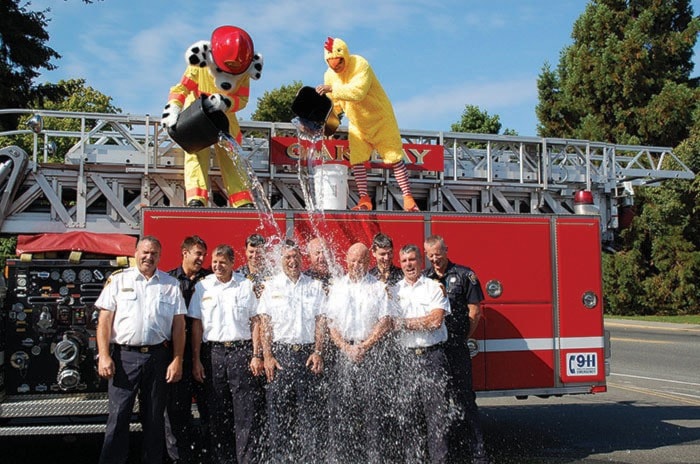A cool viral trend promoting awareness for amyotrophic lateral sclerosis (ALS), called the “Ice Bucket Challenge,” has spread to Oak Bay.
The challenge involves the participant dumping a tub of icy water over their own head, and started appearing online late last month.
For those who take part, it’s customary to issue the challenge to others, which has helped it spread across Hollywood, with many celebrities taking up the challenge on television and online.
The Oak Bay Fire Department took the challenge on Monday after being nominated by the Saanich Fire Department and Chief Constable Andy Brinton of the Oak Bay Police Department.
“We’ll all collectively make a donation as well,” said Tom Pearse, deputy fire chief of the Oak Bay Fire Department. “To raise awareness of the disease and to help them get some money to fund their research.”
After getting soaked, the Oak Bay Fire Department then challenged the Greater Victoria Fire Chiefs Association, the Victoria Fire Department Local 730 and the Oak Bay Public Works managers.
The society managed to raise $55,000 through last year’s Walk for ALS, and is hoping the Ice Bucket Challenge will bring more people to the walk and help them raise even more.
“It doesn’t matter how we do it, we just want to raise awareness for ALS,” said Ellen Mahoney, president of the ALS Society of B.C.’s Victoria chapter. “We definitely want a cure for the 3,000 Canadians living with the disease.”
The Walk for ALS takes place Sept. 14, 11:30 a.m., starting at parking lot six of the University of Victoria.
Did you know?
• ALS (also known as Lou Gehrig’s Disease) is a progressive neuromuscular disease in which nerve cells die and leave voluntary muscles paralyzed.
• Every day two or three Canadians die of the disease.
